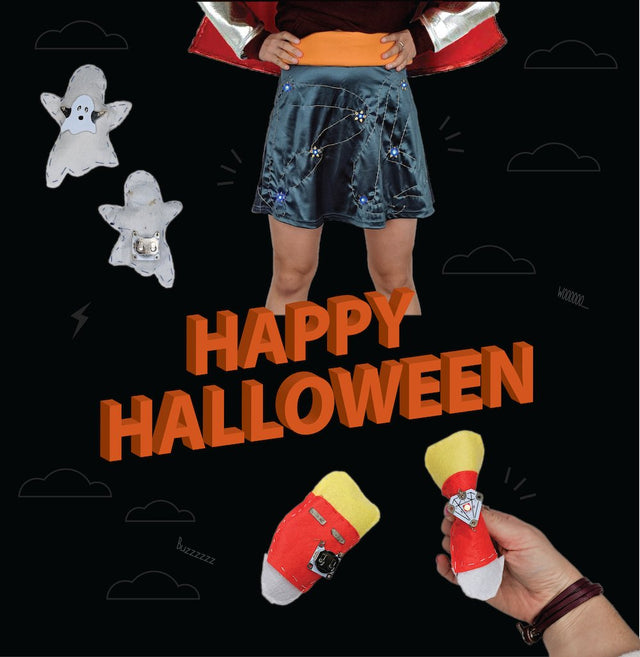Halloween Themed STEM Activities in the Classroom
Halloween themed STEM activities are a great way to bring some spooky holiday fun into your classroom. Halloween is the perfect holiday for hobbyists of all kinds. Makers, crafters, tinkerers, inventors, engineers — there’s something for everybody.
As educators, it can be an exciting challenge to come up with ideas for Halloween activities in the classroom. Decorations, costumes, candy, there is so much stuff everywhere. As fun as shopping for Halloween might be, there’s nothing more fulfilling than DIY projects for Halloween. You can encourage your students to think creatively, and use their imagination to come up with things you cannot find in any supermarket.
STEM activities in the classroom can easily be made modular. That is, each student can be given the same basic materials and framework, but the outcome doesn’t have to be dictated by the teacher. We can demonstrate this with a scenario where a simple STEM concept is introduced in the classroom, followed by guided self-exploration.
Let’s create a lesson plan where students learn how circuits work. For this activity to have a Halloween twist, we are going to use Teknikio’s Ghost LED board.
Materials
- Ghost LED board
- Conductive tape
- Scissors
Learning Outcomes
Students will be able to
- understand how circuits work
- identify conductive material
- create their own Halloween themed invention
Demonstration
To explain the basic principles of conductivity and power and correct circuits, we can use a few different materials to put together a basic LED circuit.
When something is conductive, it means electricity can flow through it easily. Metals, like copper and aluminum, are good conductors. On the other hand, a material like rubber cannot conduct electricity, and so is used as an insulator.
First, let’s use alligator clips to make a circuit with a battery that lights up an LED.
Next, let’s make the same circuit, but this time in place of the alligator clips, we’ll use conductive tape. This simple demonstration can help students grasp the difference between conduction itself, which is the underlying principle that stays the same, and any one particular conducting material, which can change from case to case.
The alligator clips have metal wire running through them, and conductive tape is actually woven silver threads with adhesive. Hence, they’re both able to conduct electricity. Can you think of an unusual material that can conduct electricity? [Hint: it’s your skin!]
Now, ask your students when they might use each material. This is a great way to introduce the concept of prototyping: the practice of quickly trying out an idea to test if it works.
Crowdsource some ideas on which situations you might want to use conductive tape. Conductive tape is one of the easiest ways to incorporate electronics with fabric, paper, and a range of other materials that are perfect for DIY projects.
Encourage your students to think out loud. There are no wrong ideas, only wrong connections! So the best way to find out if a circuit will work is to try it out. Feel free to hint at unusual combinations with their favorite accessories, gadgets, and movie characters. Here are three inventions to jumpstart their creativity:
Where to Find Your STEM Project Materials
Teknikio is offering a limited edition GhostLED Tote Kit available through Halloween. And beyond Halloween, our Fabtronic Sewing Kit has everything you need to start crafting wearables. Once you start sewing with circuits, you can create anything you can imagine, from capes, to bracelets, to face masks. If you would like to use this in your classroom, it is also available as the Fabtronic Sewing Bundle, with enough components for up to 25 students. All parts are reusable so you can make and remake as many times as you want!
Where To Look For More Halloween STEM Ideas
It’s important for students to feel a sense of autonomy in the classroom when planning activities. Studies show that when students have a say in what projects to work on in class, or designing their homework, they feel a greater sense of ownership and motivation. STEM activities are the perfect tool to help each child bring their individual creativity forward.
As we illustrated in this post, the key is to let go of some control. It can feel risky (and scary!) as teachers to not have a set plan for where your students might end up, but that is exactly the power of STEM education. According to the ISTE learning standards, empowered learners “leverage technology to take an active role in choosing, achieving, and demonstrating competency in their learning goals, informed by the learning sciences.”
Students are much more likely to internalize concepts when they try things out for themselves. Quizzing students theoretically can be important in some contexts. But that might instill a culture of memorizing the ‘right answers’ without understanding the whys behind science and technology.
By contrast, hands-on learning employs other senses like touch. To make sure students are not discouraged and frustrated when experimenting, introduce ideas like iterative design, troubleshooting, and debugging. This can positively impact students’ resilience and emotional wellbeing. Here is an example of troubleshooting using Teknikio’s conductive tape.
We’ll be back soon with a project for more advanced students using our Bluebird microcontroller. In the meantime, you can download this lesson plan as a printable PDF that you can use in your classroom. If you are an educator who would like to use Teknikio’s STEM learning tools, please feel free to get in touch with us.


0 Comments
There are no comments for this article. Be the first one to leave a message!